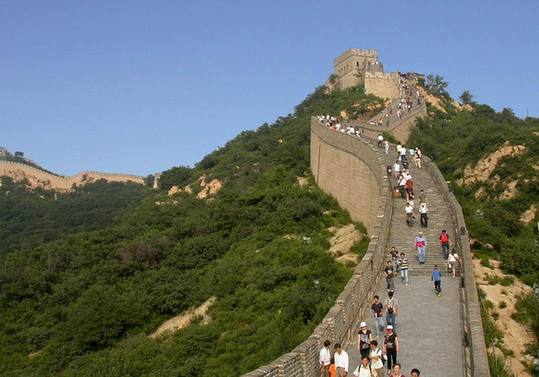Hiking China's greatest treasure
|
|
|
Great Wall |
Surely no tourist to China can ever leave the country without visiting the Great Wall. Along with the Forbidden City and the terracotta warriors, the Great Wall is one of this country's most famous treasures – if not indeed it's most famous.
But rather than just taking a tourist bus out to Badaling or to any of the other popular spots that are crowded with tourists and trinket sellers, why not hike along the wall in a more remote area? Then you can savour the wall's grandeur in peace while experiencing it step by step.
I decided to join Beijing Hikers on one of the company's recent trips out to the wall. This particular walk was called the "Switchback Hike" and entailed a three-hour hike covering just less than seven kilometres. The hike took me and a small group of other hikers to a maximum elevation of 1,073 metres.
Our hike started out near the town of Chenjiapu, in Yanqing County, near to the border of Hebei Province. We took in sweeping views of the Yan mountain range as we scrambled up hillside and finally made our way along parts of the Great Wall.
We took a short rest on the top of a general's tower before switching back and heading down along the wall until we reached the foot of the hills. The day's adventure was topped off with a delicious lunch at a small local restaurant.
I was far from the fittest in the group, although there were a few people in my group who were older than me but the guides made sure that nobody got lost or left behind. One of our guides, Zach Chen, stayed at the back of the line to keep an eye on those of us who were either finding the route a bit of a struggle or simply dawdling along to shoot photographs or enjoy the views.
The Great Wall of China is known as Changcheng in Chinese, which literally translates as long city fortress. It has been built and rebuilt over the centuries, but was originally built during the Warring States period, so that's from the 5th century BC on. The wall was reconstructed and maintained between the 5th century BC and the 16th century to protect the northern borders of the Chinese Empire.
One of the most famous sections of the wall was built between 220 and 206 BC by the first Emperor of China, Qin Shi Huang. Little of that wall now remains. Most of what remains of the wall today was built during the Ming Dynasty, so from 1368 through to 1644.
The wall stretches from Shanhai Pass, which is in China's eastern Hebei Province, to Lop Nur, or Lake Lop, far out west in Xinjiang Uygur Autonomous Region.
The Great Wall is not a continuous wall but is in fact a collection of short walls that follow the crest of hills on the southern edge of the Mongolian plain. It extends for thousands upon thousands of kilometres and to this day sections of it are still being discovered. In fact, more than 700 kilometres of ancient Great Wall have been recently discovered in Gansu and Shaanxi provinces.
The wall may be huge and continually growing as more parts of it are discovered, but there is one fact about its size that needs to be set straight. According to urban legend, the Great Wall is the only manmade structure that can be seen from the moon. It is a myth that is hundreds of years old. One of the earliest references to this myth appears in a letter penned in 1754 – way before any man ever set foot on the moon.
The Great Wall at its widest is 9.1 meters. The structure is virtually the same colour as the soil surrounding it, and so, apparently, the width of the Great Wall from the moon is the equivalent of that of a human hair viewed from three kilometres away. So, if you want to see the Great Wall you will indeed have to come to the Middle Kingdom.
 0
0 









Go to Forum >>0 Comments